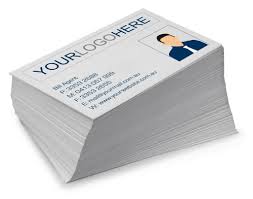Business cards are a small but very important marketing element. They are a big part of the first impression you make on someone you meet for the first time, and every time they look at your business card for your contact details they are reminded of that impression by what they see there.
Most people in business have a system for handling business cards. They can go into a folder with separate pockets for each card; they can be put into an indexed box where cards are filed alphabetically, or sometimes they just wind up in a drawer in a pile of cards held together with a rubber band. Whatever system is used, business cards tend to stay around for a fairly long time.
There are ways to add to the impact your card makes, both at the time it’s handed over and every time it’s viewed after that.
Physical Qualities
Your card should be a standard size. Anything that’s too big won’t fit into the files or other systems designed to hold collections of business cards and that means it’s either going to be tossed out or, if you’re lucky, trimmed to fit. If in doubt, err on the side of a smaller rather than larger card size.
It should be printed on a good quality card stock. Flimsy cards make the wrong impression as well as being especially vulnerable to wear and tear. The material should be resistant to damage and to becoming dingy when handled.
Contents
What goes on your business card requires careful thought. The first purpose is to allow someone to get in touch with you easily. That means including your name, title, company name, business address, phone number(s), fax number and email address at the very least. Also show your company’s website if it has one.
Some of the other things that can go on your card are the names of the products or services you sell, your own academic and professional qualifications, and a corporate logo.
Layout
Most cards are laid out in a horizontal format. Deviating from this can often make your card out of place in someone’s collection. So too can having an extra fold or a cutout in the design.
Double-sided cards are de rigeur in international business but this can mean that only one side of your card is viewable when it’s put into a folder. Put all your most important information on the front and if you do print on both sides make sure that only the less important details go on the reverse.
Use a font that’s easy to read. Despite the tendency in this era of electronically-reproduced type toward using smaller fonts, business cards are often handed over in less than ideal lighting conditions, or perused by someone with vision that’s well below the 20/20 ideal.
Style
Your business card is a representation of both you and your company. As such it should reflect your company’s market positioning. A card that’s too colorful or showy can make the wrong impression if it’s used by a professional services firm. In the same way, a card that’s dull and conservative won’t make the right impression for a progressive graphic designer.
Using a photograph is an option but not necessarily the right one to choose. Again, ask yourself whether it’s in keeping with the work you do and the business you represent. It’s appropriate for a car salesman since it can remind a prospective customer of who it was they spoke to on a day of comparison shopping at a number of dealerships, but probably not for stockbrokers or medical practitioners who know their clients and patients well.
Or be Unconventional
As a final thought that goes against most of the above advice, you can also consider a very different kind of business card if you really want to stand out from everyone else, but it definitely means you’re not going to fit into the conventional card filing systems.
Business cards can be intended to make a big first impression by being very different. Some examples include having the usual information reproduced on a fridge magnet, a pad of Post-it notes, a drink coaster or a even a mousepad.
Copyright 2004, RAN ONE Inc. All rights reserved. Reprinted with permission from www.ranone.com.

 Chris’ combination of academic credentials, career experience and temperament ideally suit his calling as a business development advisor. Clients say he has a mind for business and a heart for service.
Chris’ combination of academic credentials, career experience and temperament ideally suit his calling as a business development advisor. Clients say he has a mind for business and a heart for service.